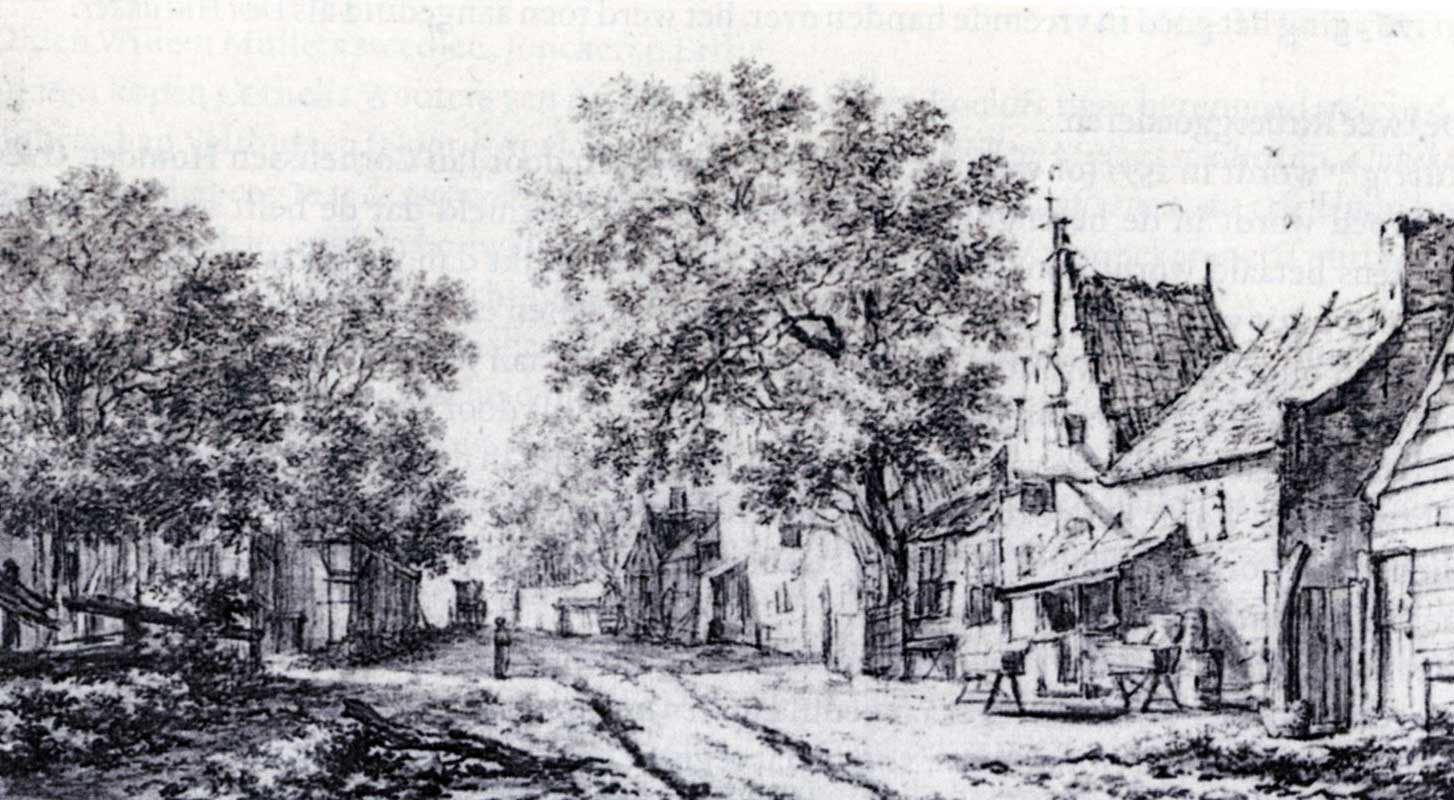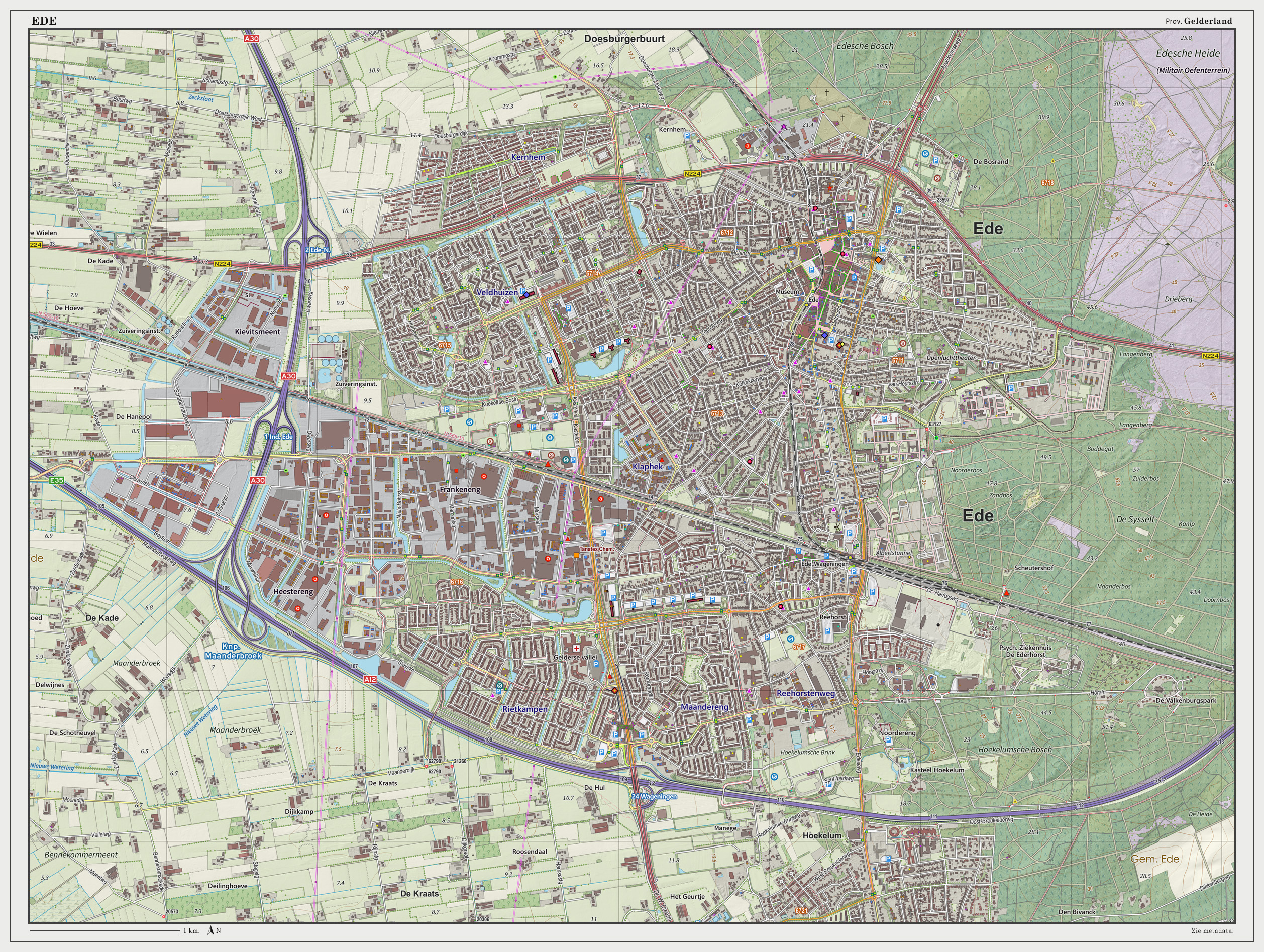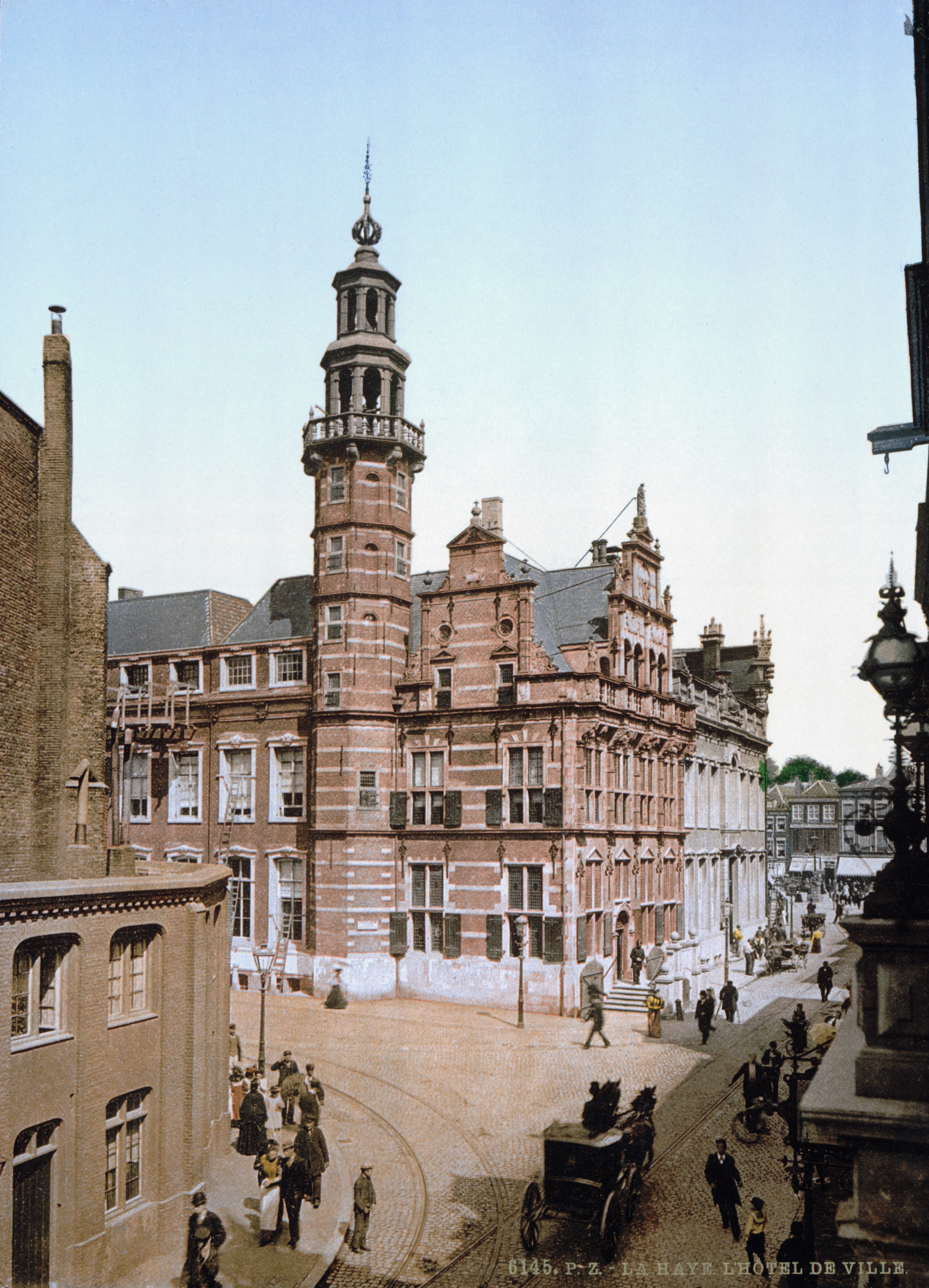|
Hoenderloo
Hoenderloo () is a Dutch village located south west of the city of Apeldoorn. Most of the village is part of the municipality of Apeldoorn, but a small part belongs to the municipality of Ede, among which the hamlet Hoog Baarlo. The village is located in the Southern part of the Veluwe and close to the national park Hoge Veluwe and the Deelerwoud. It is a very touristic village, with a large number of camping sites, recreation parks, restaurants, hotels and shops. History It was first mentioned in 1748 as "Hoender Lo Struycken", and means forest with galliformes. In 1813, the shephard Albert Brinkenberg becomes the first official resident. In 1840, there were 24 sod houses at the site. In 1841, during his travels the vicar Ottho Heldring stumbled upon the remote village and decided to invest in the village by building a well, a school in 1846 and a church in 1858. In 1848, a predecessor of the current Hoenderloo Group, at that time an institution for underprivileged boys, ... [...More Info...] [...Related Items...] OR: [Wikipedia] [Google] [Baidu] |
Ottho Gerhard Heldring
Ottho Gerhard Heldring (17 May 1804 – 11 July 1876) was a Dutch preacher and philanthropist who believed in justification through faith but also in social work. He was one of the early leaders of the Dutch temperance movement. He is known for establishing homes and schools for prostitutes wishing to start a new life and for vulnerable girls and young women. Early years Ottho Gerhard Heldring was born on 17 May 1804 at Zevenaar, the third son of Reverend Ottho Gerhard Heldring (1762–1841) and Louisa Geertruida Janssen (1764–1840). Heldring grew up in a pietist family environment. He went to Utrecht to study theology when he was sixteen, but was deeply disturbed by the humanistic and rationalistic theology he was exposed to there, and abandoned his studies after a spiritual crisis. He worked on the land for a period, then at his father's request became a pastor. He was admitted to this profession by the Hemmen municipality and confirmed on 25 March 1827. He would remain in this ... [...More Info...] [...Related Items...] OR: [Wikipedia] [Google] [Baidu] |
Apeldoorn
Apeldoorn (; Dutch Low Saxon: ) is a municipality and city in the province of Gelderland in the centre of the Netherlands. The municipality of Apeldoorn, including the villages of Beekbergen, Loenen (Apeldoorn), Loenen, Ugchelen and Hoenderloo, had a population of 165,525 on 1 December 2021. The western half of the municipality lies on the Veluwe ridge, with the eastern half in the IJssel valley. The city of Apeldoorn The oldest known reference to Apeldoorn, then called Appoldro, dates from the 8th century. The settlement came into being at the point where the old road from Amersfoort to Deventer crossed that from Arnhem to Zwolle. A 1740 map refers to it as A''pp''eldoorn.Stenvert, R. et al. (2000). ''Monumenten in Nederland: Gelderland'', p. 14 and 68–77. Zwolle: Waanders Uitgevers. Close by is the favourite country-seat of the royal family of the Netherlands called the palace het Nieuwe Loo (now Het Loo). It was originally a hunting lodge of the dukes of Gelder ... [...More Info...] [...Related Items...] OR: [Wikipedia] [Google] [Baidu] |
Marskramerpad
The E11 European long distance path or E11 path is one of the European long-distance paths, running 4700 km (about 2900 miles) west-east from The Hague in the Netherlands through Germany, Poland, Lithuania, Latvia to Tallinn, Estonia. It starts in Scheveningen, a fishing community, commercial harbor and spa in The Hague on the Dutch coast of the North Sea. It ends in Tallinn, a medieval Hanseatic town situated side by side with the 21st century city of modern glass buildings, located on the shore of the Gulf of Finland of the Baltic Sea. The E11 is one of three European long distance paths running East from the Benelux to the Baltic states. In the North, following the German, Polish, Lithuanian, Latvian and Estonian coasts of North Sea and Baltic Sea, the E9 offers a variety of polders, sandy and rocky beaches, dunes, coastal meadows and commercial harbors. In Estonia the route goes along the very seashore for around 100 km, mainly between Haapsalu and Tallinn. But in oth ... [...More Info...] [...Related Items...] OR: [Wikipedia] [Google] [Baidu] |
Jan Ingenhoven
Johannes Theodorus (Jan) Ingenhoven (Breda, 19 May 1876 – Hoenderloo, 20 May 1951), was a Dutch composer and conductor. He was one of the first to introduce new influences shaping twentieth century European music into the Netherlands before World War 1, and also took contemporary Dutch music into Germany.Anthony Zielhorst'Ingenhoven, Jan', in ''Grove Music Online''(2001) Career Jan Ingenhoven was born into a family of gifted amateur musicians: his father (a baker) played oboe and violin and an uncle played the saxophone. He learned the clarinet at an early age, sang in a choir and was soon conducting local choirs in Breda and Dordrecht. From 1902 he studied harmony and composition with Ludwig Felix Brandts Buys (1847–1917). After his marriage to Johanna Hermine Frantzmann in 1905 he settled in Munich and continued his studies with the Austrian conductor Felix Mottl. Ingenhoven promoted Dutch music abroad, organizing a Dutch Music Festival in Munich in 1906 that included his own ... [...More Info...] [...Related Items...] OR: [Wikipedia] [Google] [Baidu] |
Ede, Netherlands
Ede () is a city and Municipalities of the Netherlands, municipality in the Netherlands, in the Provinces of the Netherlands, province of Gelderland. municipality had 123,532 inhabitants, and as of 1 January 2023 the city had 79.435 inhabitants . Population centres Community: * Ede (town) * Bennekom * De Klomp * Deelen * Ederveen * Harskamp * Hoenderloo * Lunteren * Otterlo (Kröller-Müller Museum) * Wekerom Location The town itself is situated halfway between the larger cities of Arnhem and Utrecht (city), Utrecht, with direct rail and road connections to both cities. There are no connections to any water nearby; however, there also is a direct road connection to the city of Wageningen which hosts a small industrial port on the river Rijn and a direct road and rail connection to the city of Arnhem, which features a larger port at a greater distance. The environment is clean and green because Ede is partly built in a forest and partly on the central Dutch plains in the ... [...More Info...] [...Related Items...] OR: [Wikipedia] [Google] [Baidu] |
Hoge Veluwe National Park
De Hoge Veluwe National Park (; "The High Veluwe") is a Dutch national park in the province of Gelderland near the cities of Ede, Wageningen, Arnhem and Apeldoorn. It is approximately in area, consisting of heathlands, sand dunes, and woodlands. It is situated in the Veluwe, the area of the largest terminal moraine in the Netherlands. Most of the landscape of the park and the Veluwe was created during the last ice age. The alternating sand dune areas and heathlands may have been caused by human utilization of the surrounding lands. The park forms one of the largest continuous nature reserves in the Netherlands. History The park was established by the businessman Anton Kröller and his wife Helene Kröller-Müller as a private estate in 1909. Up until 1923 the park was under construction with wildlife being imported and the building of the hunting lodge and fences. The hunting residence is called ''St. Hubertus Hunting Lodge'' after St. Hubertus and was designed by promine ... [...More Info...] [...Related Items...] OR: [Wikipedia] [Google] [Baidu] |
SS And Police Leader
The title of SS and Police Leader (') designated a senior Nazi Party official who commanded various components of the SS and the German uniformed police (''Ordnungspolizei''), before and during World War II in the German Reich proper and in the occupied territories. Levels Three levels of subordination were established for holders of this title: * SS and Police Leader (''SS- und Polizeiführer'', SSPF) * Higher SS and Police Leader (''Höherer SS- und Polizeiführer'', HSSPF) * Supreme SS and Police Leader (''Höchster SS- und Polizeiführer'', HöSSPF) Establishment The office of ''Höherer SS- und Polizeiführer'' (Higher SS and Police Leader, HSSPF) was authorized by a decree of 13 November 1937, signed by Reich Interior Minister Wilhelm Frick. This decree authorized the creation of HSSPF in each of the 13 German armed forces ''Wehrkreise'' (Military Districts) in the German Reich, but only in the event of mobilization. At that time, the HSSPF would serve as deputies un ... [...More Info...] [...Related Items...] OR: [Wikipedia] [Google] [Baidu] |
Helene Kröller-Müller
Helene Emma Laura Juliane Kröller-Müller (; ; 11 February 1869 – 14 December 1939) was a German art collector. She was one of the first European women to put together a major art collection. She is credited with being one of the first collectors to recognise the genius of Vincent van Gogh. Her entire collection was eventually sold to the Dutch government, along with her and her husband, Anton Kröller's, large forested country estate. Today it is the Kröller-Müller Museum and sculpture garden and Hoge Veluwe National Park, one of the largest national parks in the Netherlands. Life and career Helene Emma Laura Juliane Müller was born in , Essen, into a wealthy industrialist family. Her father, Wilhelm Müller, owned Wm. H. Müller & Co., a prosperous supplier of raw materials to the mining and steel industries.Joshua Levine (21 May 2009)The Vision Quest of Helene Kroller-Muller''Forbes'' magazine. She studied under painter Henk Bremmer in 1906–1907. As she was on ... [...More Info...] [...Related Items...] OR: [Wikipedia] [Google] [Baidu] |
Hendrik Petrus Berlage
Hendrik Petrus Berlage (; 21 February 185612 August 1934) was a Dutch architect and designer. He is considered one of the fathers of the architecture of the Amsterdam School. Life and work Hendrik Petrus Berlage, son of Nicolaas Willem Berlage and Anna Catharina Bosscha, was born on 21 February 1856 in Amsterdam in the Netherlands. Anna Catharina Bosscha's uncle was Johannes Bosscha, a scientist who taught in Polytechnische School te Delft. Berlage studied architecture at the ETH Zurich, Zurich Institute of Technology between 1875 and 1878 after which he traveled extensively for three years through Europe. In the 1880s he formed a partnership in the Netherlands with Theodore Sanders which produced a mixture of practical and utopian projects. A published author, Berlage held memberships in various architectural societies including Congrès International d'Architecture Moderne, CIAM I. Berlage was influenced by the Neo-Romanesque brickwork architecture of Henry Hobson Richar ... [...More Info...] [...Related Items...] OR: [Wikipedia] [Google] [Baidu] |
Hiking Route E11
A hike is a long, vigorous walking, walk, usually on trails or footpaths in the countryside. Walking for pleasure developed in Europe during the eighteenth century. Long hikes as part of a religious pilgrimage have existed for a much longer time. "Hiking" is the preferred term in Canada and the United States; the term "walking" is used in these regions for shorter, particularly urban walks. In the United Kingdom and Ireland, the word "walking" describes all forms of walking, whether it is a walk in the park or backpacking (wilderness), backpacking in the Alps. The word hiking is also often used in the UK, along with rambling, hillwalking, and fell walking (a term mostly used for hillwalking in northern England). The term bushwalking is endemic to Australia, having been adopted by the Sydney Bush Walkers Club in 1927. In New Zealand a long, vigorous walk or hike is called Tramping in New Zealand, tramping. It is a popular activity with numerous :Hiking organizations, hiking organ ... [...More Info...] [...Related Items...] OR: [Wikipedia] [Google] [Baidu] |
The Hague
The Hague ( ) is the capital city of the South Holland province of the Netherlands. With a population of over half a million, it is the third-largest city in the Netherlands. Situated on the west coast facing the North Sea, The Hague is the country's administrative centre and its seat of government, and has been described as the country's ''de facto'' capital since the time of the Dutch Republic, while Amsterdam is the official capital of the Netherlands. The Hague is the core municipality of the COROP, Greater The Hague urban area containing over 800,000 residents, and is also part of the Rotterdam–The Hague metropolitan area, which, with a population of approximately 2.6 million, is the largest metropolitan area of the Netherlands. The city is also part of the Randstad region, one of the largest conurbations in Europe. The Hague is the seat of the Cabinet of the Netherlands, Cabinet, the States General of the Netherlands, States General, the Supreme Court of the Neth ... [...More Info...] [...Related Items...] OR: [Wikipedia] [Google] [Baidu] |






